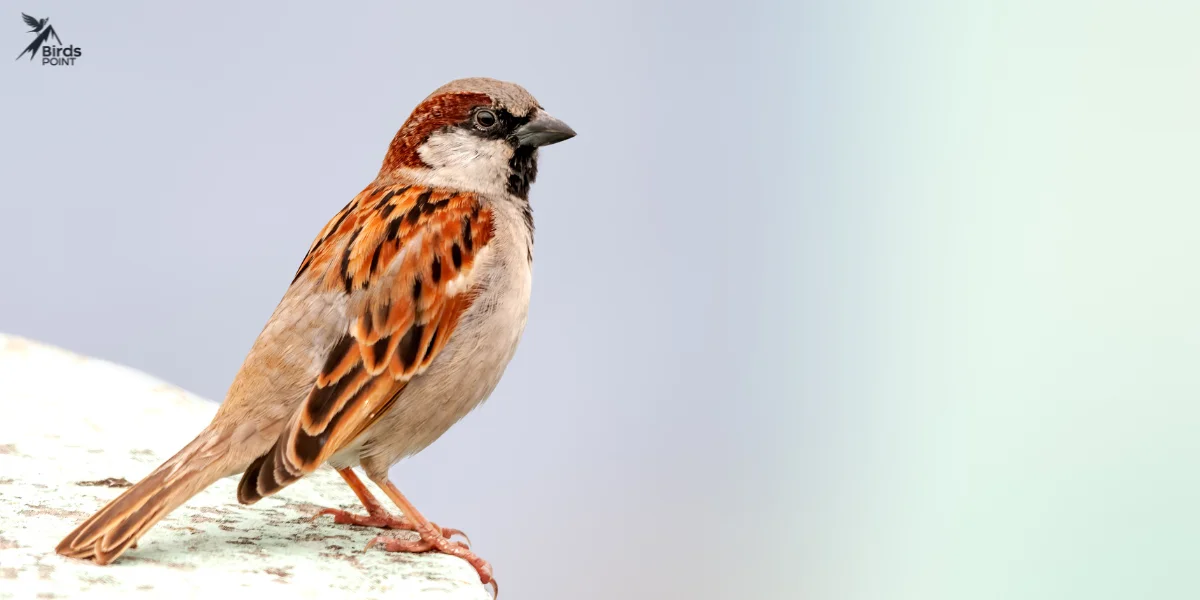Sparrows are small birds that are found all over Michigan. They are common in both cities and the countryside. These birds are easy to spot because of their small size and active behavior. Sparrows in Michigan come in different types, and each has its own unique features. They play an important role in the environment by eating insects and helping to control pests. Whether you are in your backyard or walking through a park, you are likely to see these lively little birds.
List of 8 sparrows found in Michigan
| Number | Sparrow Name | Description |
|---|---|---|
| 1 | House Sparrow | Small, brown bird with a gray head and black bib. |
| 2 | American Tree Sparrow | Rusty cap, gray face, and a small dark spot on the chest. |
| 3 | Song Sparrow | Brown with streaks on the chest and a distinctive melody. |
| 4 | Chipping Sparrow | Brown body, rusty cap, and a black eye stripe. |
| 5 | Field Sparrow | Pale brown, with a pink beak and white eye ring. |
| 6 | White-throated Sparrow | Brown with a white throat patch and yellow spots near the eyes. |
| 7 | Fox Sparrow | Large, rusty brown with streaked chest and thick beak. |
| 8 | Savannah Sparrow | Brown with streaked chest and a yellowish eyebrow stripe. |
8 sparrows found in Michigan: Details
Sparrows are among the most common birds in Michigan. These small birds are known for their simple yet beautiful appearance and their active behavior. There are several types of sparrows found in Michigan, each with its own unique features. In this article, we will explore eight different sparrows that you can find in the state. We’ll look at their physical characteristics, habitats, behaviors, and what makes each one special.
1. House Sparrow
The House Sparrow is perhaps the most well-known sparrow in Michigan. This small bird has a stout body, short legs, and a short, thick beak. The male House Sparrow has a gray head, black bib, and chestnut-colored back with white cheeks. The female, on the other hand, is mostly brown with streaks on her back and a pale, unstreaked chest. Both males and females have a simple but pleasant chirping song.

Habitat:
House Sparrows are commonly found in cities, towns, and agricultural areas. They are highly adaptable birds and can live near people, often making their nests in buildings, street lights, or other structures.
Behavior:
These sparrows are social birds and are often seen in flocks. They are not shy around humans and can be quite bold when searching for food. House Sparrows feed mainly on seeds, grains, and crumbs but will also eat insects, especially during the breeding season.
| Characteristic | Details |
|---|---|
| Scientific Name | Passer domesticus |
| Lifespan | 3-5 years |
| Size | 6-7 inches (15-18 cm) |
| Weight | 0.9-1.4 ounces (25-40 g) |
| Diet | Seeds, grains, insects, crumbs |
| Breeding Season | March to August |
| Clutch Size | 3-5 eggs |
| Conservation Status | Least Concern |
2. American Tree Sparrow
The American Tree Sparrow is a small, slender bird with a rusty cap, gray face, and a small dark spot in the middle of its chest. It has a bicolored bill, with the upper part dark and the lower part yellow. Its back is streaked with brown, and it has two white wing bars.

Habitat:
These sparrows are found in open areas, such as fields, meadows, and marshes, particularly during the winter months when they migrate to Michigan. They are more commonly seen in the northern parts of the state.
Behavior:
American Tree Sparrows are ground foragers, meaning they search for food on the ground. Their diet consists mostly of seeds and insects. They are also known for their sweet, musical songs, which they sing from low perches or while in flight.
| Characteristic | Details |
|---|---|
| Scientific Name | Spizelloides arborea |
| Lifespan | 2-4 years |
| Size | 5.5-6.3 inches (14-16 cm) |
| Weight | 0.5-0.8 ounces (13-23 g) |
| Diet | Seeds, insects, fruits |
| Breeding Season | May to July |
| Clutch Size | 4-6 eggs |
| Conservation Status | Least Concern |
3. Song Sparrow
The Song Sparrow is easily recognized by its brown streaked body and a distinctive dark spot on its chest. It has a long, rounded tail and a broad head with a gray face. The streaks on its chest often form a central spot, giving it a unique appearance.
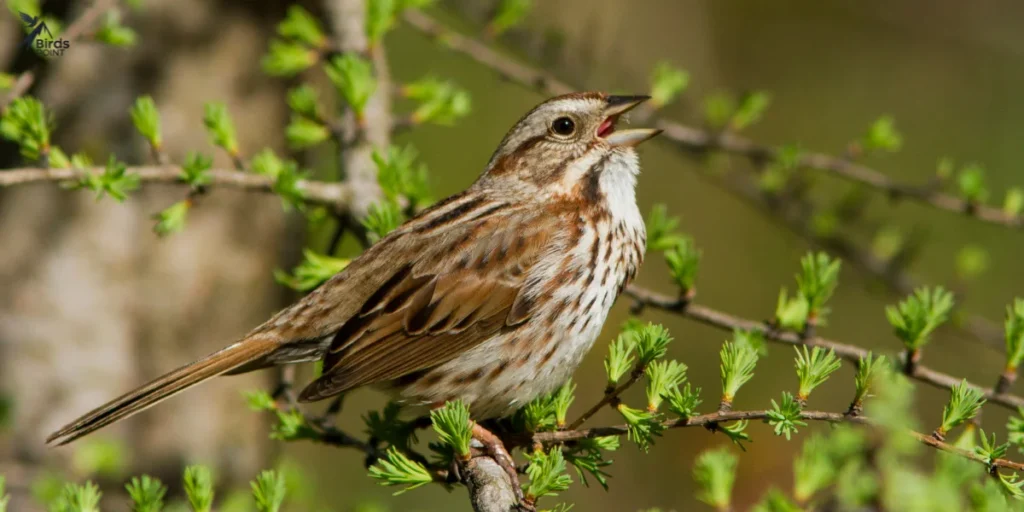
Habitat:
Song Sparrows are found in a variety of habitats, including wetlands, grasslands, and gardens. They are particularly common in areas with dense vegetation, such as bushes and shrubs, where they can easily find cover.
Behavior:
These sparrows are known for their beautiful and complex songs, which vary from one individual to another. They use their songs to defend their territory and attract mates. Song Sparrows are ground foragers, feeding on seeds, insects, and fruits.
| Characteristic | Details |
|---|---|
| Scientific Name | Melospiza melodia |
| Lifespan | 3-7 years |
| Size | 4.7-6.7 inches (12-17 cm) |
| Weight | 0.5-0.7 ounces (12-18 g) |
| Diet | Seeds, insects, fruits |
| Breeding Season | April to August |
| Clutch Size | 3-5 eggs |
| Conservation Status | Least Concern |
4. Chipping Sparrow
The Chipping Sparrow is a small, slender bird with a rusty red cap, black eye stripe, and a pale gray belly. Its back is streaked with brown, and it has a relatively plain face. During the winter, its colors become duller, making it less distinct.

Habitat:
Chipping Sparrows are commonly found in open woodlands, gardens, and parks. They prefer areas with scattered trees and shrubs where they can find both food and nesting sites.
Behavior:
Chipping Sparrows are active birds that often forage on the ground or in low vegetation. Their diet mainly consists of seeds and insects. They are also known for their sharp, “chip” call, which gives them their name. During the breeding season, males sing a simple, fast trill to establish their territory.
| Characteristic | Details |
|---|---|
| Scientific Name | Spizella passerina |
| Lifespan | 3-5 years |
| Size | 4.7-5.9 inches (12-15 cm) |
| Weight | 0.4-0.5 ounces (11-14 g) |
| Diet | Seeds, insects |
| Breeding Season | May to July |
| Clutch Size | 3-4 eggs |
| Conservation Status | Least Concern |
5. Field Sparrow
The Field Sparrow is a small, pale brown bird with a distinct pink beak and a white eye ring. Its back is streaked with brown, and it has a relatively plain face with a slight reddish-brown cap. The overall appearance of this sparrow is soft and delicate.

Habitat:
Field Sparrows prefer open fields, meadows, and areas with scattered shrubs. They are often found in overgrown fields and pastures, where they can find both food and nesting sites.
Behavior:
These sparrows are shy and often stay hidden in tall grass or shrubs. They have a distinctive, sweet, and melodic song that starts with a few clear notes and then speeds up, resembling the sound of a bouncing ball. Field Sparrows primarily eat seeds and insects, foraging mostly on the ground.
| Characteristic | Details |
|---|---|
| Scientific Name | Spizella pusilla |
| Lifespan | 4-6 years |
| Size | 4.7-5.9 inches (12-15 cm) |
| Weight | 0.4-0.5 ounces (11-13 g) |
| Diet | Seeds, insects |
| Breeding Season | April to August |
| Clutch Size | 2-5 eggs |
| Conservation Status | Least Concern |
6. White-throated Sparrow
The White-throated Sparrow is a striking bird with a brown streaked body, white throat patch, and bright yellow spots between its eyes and beak. It also has a black and white striped head and a grayish belly. Its distinctive white throat is a key identifying feature.
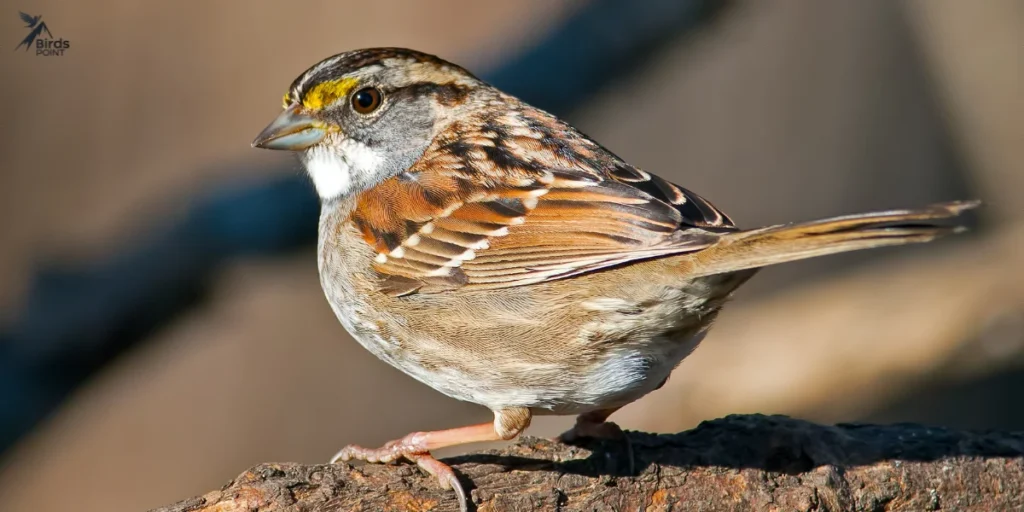
Habitat:
White-throated Sparrows are found in forests, woodlands, and areas with dense undergrowth. They prefer places with a mix of trees and open spaces where they can forage on the ground.
Behavior:
These sparrows are known for their clear and melodious whistles, which sound like they are singing “Old Sam Peabody, Peabody, Peabody.” They are ground foragers, eating seeds, insects, and berries. During migration, they are often seen in large flocks.
| Characteristic | Details |
|---|---|
| Scientific Name | Zonotrichia albicollis |
| Lifespan | 9-11 years |
| Size | 6.3-7.1 inches (16-18 cm) |
| Weight | 0.8-1.1 ounces (22-32 g) |
| Diet | Seeds, insects, fruits |
| Breeding Season | May to August |
| Clutch Size | 3-5 eggs |
| Conservation Status | Least Concern |
7. Fox Sparrow
The Fox Sparrow is a large, robust sparrow with a rusty brown color and bold streaks on its chest and sides. Its thick, triangular bill and strong legs make it well-suited for scratching the ground in search of food. The overall appearance of this bird is chunky and heavily streaked.
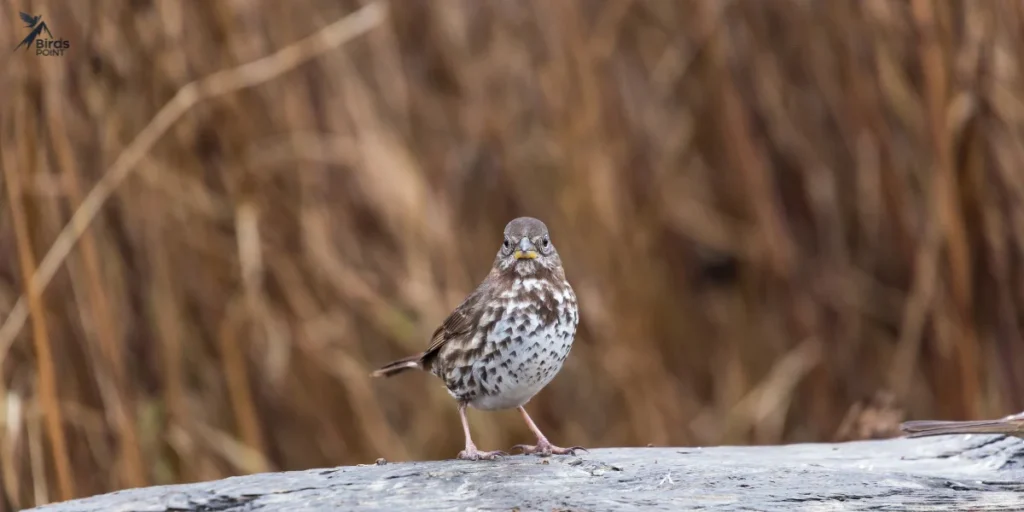
Habitat:
Fox Sparrows are typically found in dense shrubs, forests, and brushy areas. During migration, they can be found in a wider range of habitats, including gardens and parks.
Behavior:
These sparrows are known for their strong, vigorous foraging behavior. They often scratch through leaf litter to find seeds and insects. Fox Sparrows are also good singers, with a sweet and rich song that is often heard during migration.
| Characteristic | Details |
|---|---|
| Scientific Name | Passerella iliaca |
| Lifespan | 3-6 years |
| Size | 6.3-7.5 inches (16-19 cm) |
| Weight | 0.9-1.2 ounces (26-35 g) |
| Diet | Seeds, insects |
| Breeding Season | April to July |
| Clutch Size | 3-4 eggs |
| Conservation Status | Least Concern |
8. Savannah Sparrow
The Savannah Sparrow is a small, streaked bird with a short tail and a yellowish eyebrow stripe. Its back is brown with fine streaks, and its chest is also streaked with dark brown. The yellow spot above the eye is the most distinguishing feature of this sparrow.
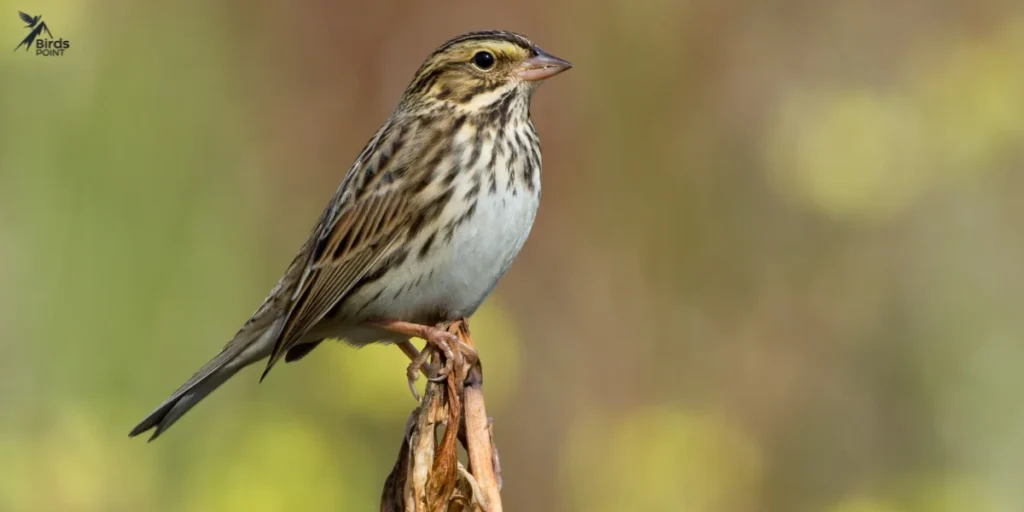
Habitat:
Savannah Sparrows are found in open areas, such as grasslands, meadows, and fields. They prefer habitats with low vegetation, where they can easily hide and find food.
Behavior:
These sparrows are ground foragers, feeding on seeds, insects, and small invertebrates. They have a high-pitched, insect-like song that is often heard in open fields. Savannah Sparrows are migratory birds, spending the winter in the southern United States and returning to Michigan in the spring.
| Characteristic | Details |
|---|---|
| Scientific Name | Passerculus sandwichensis |
| Lifespan | 3-5 years |
| Size | 4.3-6.7 inches (11-17 cm) |
| Weight | 0.5-1 ounces (15-28 g) |
| Diet | Seeds, insects |
| Breeding Season | May to July |
| Clutch Size | 3-5 eggs |
| Conservation Status | Least Concern |
Conclusion
Sparrows are an important part of Michigan’s birdlife. Each of these eight sparrows has its own unique characteristics, making them interesting and enjoyable to observe. Whether you are in a city park, a rural field, or a dense forest, you are likely to encounter one of these fascinating birds. Understanding their habits and behaviors can enhance your birdwatching experience and help you appreciate the diversity of sparrows in Michigan.
FAQs
Q: What is the most common sparrow in Michigan?
A: The House Sparrow is one of the most common sparrows found in Michigan, especially in urban areas.
Q: How can I attract sparrows to my backyard?
A: You can attract sparrows by providing bird feeders with seeds, especially millet and sunflower seeds. Planting native shrubs and trees also offers shelter and nesting sites for them.
Q: Do sparrows migrate?
A: Some sparrows, like the American Tree Sparrow, migrate to Michigan during the winter, while others, such as the House Sparrow, are year-round residents.
Q: What do sparrows eat?
A: Sparrows primarily eat seeds, grains, and insects. They may also consume fruits and crumbs, especially in urban areas.
Q: Are sparrows protected in Michigan?
A: Most native sparrows are protected under the Migratory Bird Treaty Act, but the House Sparrow, being non-native, is not protected and is considered an invasive species.
